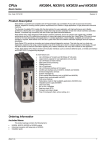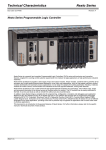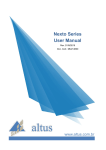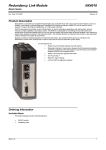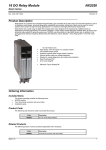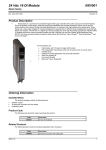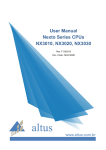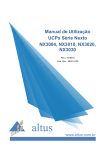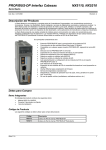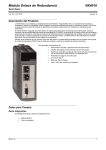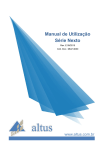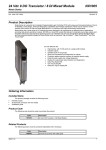Download MasterTool IEC XE MT8500
Transcript
MasterTool IEC XE Doc. Code: CE103705 MT8500 Revision: F Product Description Nexto Series is a powerful and complete Programmable Logic Controller (PLC) with unique and innovative features. Due to its flexibility, smart design, enhanced diagnostics capabilities and modular architecture, Nexto can be used for control systems from medium or high-end applications. Due to its compact size and superior performance, Nexto can also be used for small automation systems with time critical requirements. MasterTool IEC XE is a complete tool for programming, debugging and performing configuration and simulation of user applications. Based on a concept of being integrated, flexible and easy to use, this software provides six programming languages defined by IEC 61131-3 standard: Structured Text (ST), Sequential Function Chart (SFC), Function Block Diagram (FBD), Ladder Diagram (LD), Instruction List (IL) and Continuous Function Chart (CFC). MasterTool IEC XE allows the use of different languages on the same application, providing to the user a powerful way to organize the application and to reuse codes used in previous applications. This product offers features for every stage of an automation application, starting from initial graphical architecture topology analyses, passing through a programming environment that supports IEC 61131-3 languages and a realistic simulation tool, where the user can verify application’s behavior before running in a real system and ending in a complete diagnostics and status visualization interface. MasterTool IEC XE also offers two different protection schemes as application security features: IP Protection and Secure PLC Login. IP Protection is targeted to protect user’s intellectual property, allowing the user to protect the complete project and files by defining a password to access them. This means that these files will be available (both read and write operations) only after unlocking them with the correct password. Secure PLC Login provides a way to protect the user application from any unauthorized access. By enabling this feature, Nexto CPU will request a user and a password before performing any available command in MasterTool IEC XE and Nexto CPU, as stopping, programming and forcing of outputs in the target CPU. MasterTool IEC XE allows the use of fieldbus interfaces in an easier way than ever seen before. The user does not need any special software to configure fieldbuses anymore, because MasterTool IEC XE covers this requirement providing a unique tool reducing engineering time and making applications more simple. In order to increase user’s productivity, some important features are also available: Module Printing which is a report generation of every module specific parameters and application general settings, Logic Printing which is a report generation of all application code, Enhanced Project Verification which helps user to check several different conditions during programming, like programming syntax, power supply module current consumption, placement rules for Nexto modules, modules parameters and settings, Real Time Debugging which provides useful way to check the application stepby-step, verify variables values or add and remove breakpoints during Nexto CPU programming. Altus S. A. 1 MasterTool IEC XE MT8500 Doc. Code: CE103705 Revision: F Product Data Free download of MasterTool IEC XE Lite software is available on Altus website: www.altus.com.br. Related Products The following code must be used to purchase the product: Code Description MT8500 MasterTool IEC XE Note: MT8500: MasterTool IEC XE is available in four different license versions: Lite, Basic, Professional and Advanced. For further details please check the table in this document or MasterTool IEC XE User Manual - MU299609. MasterTool IEC XE Versions The following table below shows all differences between MasterTool IEC XE versions: Lite Basic Professional Advanced Free version Yes No No No Available languages Structured Text (ST) Sequential Function Chart (SFC) Function Block Diagram (FBD) Ladder Diagram (LD) Instruction List (IL) Continuous Function Chart (CFC) 6 Yes Yes Yes Yes Yes Yes 6 Yes Yes Yes Yes Yes Yes 6 Yes Yes Yes Yes Yes Yes 6 Yes Yes Yes Yes Yes Yes Supported Nexto Series CPUs 2 3 4 4 NX3004 Yes Yes Yes Yes NX3010 Yes Yes Yes Yes NX3020 No Yes Yes Yes NX3030 No No Yes Yes Rack expansion support No Yes Yes Yes Rack expansion redundancy support No No Yes Yes Ethernet expansion support No No Yes Yes Ethernet expansion redundancy support No No Yes Yes Fieldbus support No Yes Yes Yes Fieldbus redundancy support No No Yes Yes Half-Cluster redundancy support No No No Yes Limitation of number of I/O points Yes Yes No No Maximum number of I/O points 320 2048 Unlimited Unlimited Notes: Fieldbus support: Nexto Series architectures use the PROFIBUS DP as the fieldbus. Maximum number of I/O points: There is no maximum number of I/O points on MasterTool IEC XE in its Professional and Advanced versions. In this case, MT8500 does not verify anything. However, there is a limit depending of the CPU model and the %I and %Q memory occupation. Altus S. A. 2 MasterTool IEC XE Doc. Code: CE103705 MT8500 Revision: F Features IEC 61131-3 Programming Languages MasterTool IEC XE offers all editors defined in the IEC standard for application development: Structured Text (ST), Sequential Function Chart (SFC), Function Block Diagram (FBD), Ladder Diagram (LD), Instruction List (IL) and Continuous Function Chart (CFC). All editors were specially designed to ensure optimal handling. Ideas and suggestions from experienced users are incorporated into features available to general users. Some examples: When working in FBD, LD or IL you can freely switch between these editors Language elements can either be entered directly or dragged into the editor from a tool box MT8500 offers an intelligent input assistance and an extended IntelliSense functionality Standard language constructs ST language like IF and FOR can be folded and unfolded in the text editors Auto declare for constructs like IF ... END_IF and WHILE .. END_WHILE A comfortable time monitoring mechanism for handling steps as well as online diagnosis functionality, even available in the SFC editor Steps and transitions in the SFC editor and all elements in the CFC editor can be encapsulated in macros Automatically declaration of variables Graphic table for declaration of variables Editors for Project Configuration and Hardware Configuration With the aid of special editors a project can be easily configured in MasterTool IEC XE. The graphical tool allows a fast and comprehensive way to configure the system where the user just needs to drag and drop the modules in the backplanes to add them in the application. Additionally, the user has the complete visualization of the application architecture with the physical position and module information. The configuration of fieldbus networks and standard communication protocols, like PROFIBUS-DP and MODBUS protocols, are integrated in the programming tool. This feature enables the user to set all configuration parameters in a single place, avoiding the need of switching between different software tools. Object-Oriented Programming MasterTool IEC XE offers object-oriented programming with the known advantages from modern high-level languages such as JAVA or C++ like use of classes, interfaces, methods, inheritance and polymorphism. The IEC function blocks are seamlessly extended and the extensions made available to all engineering aspects. Object-oriented programming offers great advantages to the user, for example, when reusing existing parts of the application or when working on one application with several developers. Altus S. A. 3 MasterTool IEC XE Doc. Code: CE103705 MT8500 Revision: F Online, Debugging and Commissioning Features The code generated from the application is downloaded onto the target device with a single mouse click. Once MasterTool IEC XE is online, it offers many important functions for fast and efficient debugging, testing and commissioning. The values of declared variables for example are displayed directly in the program code. These values can be changed or forced without any difficulty. By setting breakpoints and then stepping through the code line by line, errors can easily be detected. Breakpoints in MasterTool IEC XE can be assigned to certain conditions to achieve even more precision in the debugging process. Using go to cursor feature, the user can follow the execution of the application through a complete cycle. If the application code is modified, it is compiled, and then loaded and activated without having to stop the controller. Changes to several POUs (Program Organization Unit), variables or data types are also possible. This functionality is called online change. Shorter development cycles and a faster production process lead to reduced costs and increased competitiveness. The sampling trace is a very useful tool when the user wants to record data or even trigger events for testing or commissioning purposes. This digital storage media, which is completely integrated in MasterTool IEC XE, can, of course, also be used to visualize application data. Simulation One feature that enables the user to evaluate and test logic and algorithms is the simulation tool. This feature enables the design and test of user applications without the need of a connected controller. This feature is also interesting for training, documentation and test cases evaluation. Since it is a simulator, some limitations, like cannot test the communication interfaces, may apply when deploying the application the end controller. User Documentation & Help Files Since programming a PLC according IEC 61131-3 standard languages is a complex task, MasterTool IEC XE offers an extensive help file with many hints and descriptions in order to guide and serve as a first knowledge and troubleshooting base while designing the logic codes or using any software features. Besides, this help file is available in different languages according to installation options. As part as user documentation, MT8500 can print out user application documents, like bill of materials (BOM), POUs, bus configuration, tag and description, among other options. Enhanced Diagnostics One of the key innovative features of Nexto Series is an extensive support of diagnostics. This idea comes from requirements of large and complex applications, where the correct use of such information is important for maintenance, troubleshooting and to predict potential issues. This feature is also present in MasterTool IEC XE where user can ac cess the complete diagnostics structures via watch windows and Diagnostics Explorer, when connected to a PLC. Function Block Libraries MasterTool IEC XE has several function block libraries ready to be used. Functions like process variable handling, mathematic functions, PID control and timers are some examples of functions that are brought together with MasterTool IEC XE. Docking View The Docking View technology allows the user to customize MasterTool IEC XE environment to meet personal needs. This feature provides a user friendly interface to maximize the experience with the software tool. Languages MasterTool IEC XE is available in Portuguese and English languages. After installed the user interface assumes the language of Computer’s Operational System. The language can be changed after the installation without execute a reinstall process. Altus S. A. 4 MasterTool IEC XE MT8500 Doc. Code: CE103705 Revision: F Compatibility with Other Products MasterTool IEC XE versions before version 1.29 are not compatible with all product revisions of Nexto Series modules. If you are using any software version or product revision of Nexto Series products, as informed on the following table, it will be necessary a software update of MasterTool IEC XE to the version 1.29 or higher. Software Version Product Revision NX1001 1.1.0.1 or higher AB or higher NX1005 1.1.0.1 or higher AB or higher NX2001 1.0.1.1 or higher AB or higher NX2020 1.0.1.1 or higher AC or higher NX3010 1.2.1.0 or higher AN or higher NX3020 1.2.1.0 or higher AH or higher NX3030 1.2.1.0 or higher AL or higher NX4000 1.1.0.0 or higher AD or higher NX4010 1.0.1.0 or higher AG or higher NX5000 1.0.1.1 or higher AJ or higher NX5001 1.1.1.1 or higher AM or higher NX6000 1.0.1.2 or higher AF or higher NX6100 1.0.1.1 or higher AE or higher MasterTool IEC XE versions before version 1.40 are not able to configure MODBUS communication drivers by Symbolic Mapping. The same behavior happens when using the LibLogs Library. It will be necessary to use the Nexto Series products with software version, or product revision, as described in the following table, when loading projects into the CPU using these drivers or library. If the use of MODBUS communication driver by Symbolic Mapping or LibLogs Library is not necessary there is no restriction to use this version. Software Version Product Revision NX3010 1.3.0.22 or higher AR or higher NX3020 1.3.0.22 or higher AL or higher NX3030 1.3.0.22 or higher AO or higher MasterTool IEC XE versions before 2.00 are not compatible with all product revisions of Nexto Series modules. If you are using any software version or product revision of Nexto Series products, as informed on the following table, it will be necessary a software update of MasterTool IEC XE to the version 2.00 or higher. Software Version Product Revision NX3010 1.4.0.33 or higher AT or higher NX3020 1.4.0.33 or higher AN or higher NX3030 1.4.0.33 or higher AQ or higher MasterTool IEC XE versions before 2.01 are not compatible with all product revisions of Nexto Series modules. If you are using any software version or product revision of Nexto Series products, as informed on the following table, it will be necessary a software update of MasterTool IEC XE to the version 2.01 or higher. Software Version Product Revision NX3004 1.5.0.18 or higher AB or higher NX3010 1.5.0.10 or higher AU or higher NX3020 1.5.0.10 or higher AO or higher NX3030 1.5.0.10 or higher AS or higher MasterTool IEC XE versions before version 2.01 are not able to configure the Machine Profile. It will be necessary to use the Nexto Series products with software version, or product revision, as described in the following table, to a project with this profile works properly. Altus S. A. 5 MasterTool IEC XE MT8500 Doc. Code: CE103705 Revision: F Software Version Product Revision NX1001 1.2.0.2 or higher AE or higher NX1005 1.2.0.3 or higher AD or higher NX2001 1.2.0.2 or higher AD or higher NX2020 1.2.0.2 or higher AE or higher NX5000 1.2.0.1 or higher AL or higher NX5001 1.2.0.6 or higher AP or higher NX6000 1.2.0.2 or higher AK or higher NX6100 1.2.0.1 or higher AI or higher Minimum Requirements for Installation and Operation The following table shows the minimum requirements for the installation and use of MasterTool IEC XE. MasterTool IEC XE Platform PC with Windows XP® (32 bits), Windows Vista® (32 bits), Windows 7® (32 bits or 64 bits) or Windows 8.1 ® (64 bits) Processor Intel Core 2 Duo 1.66 GHz (minimum) Disk space 1 Gbyte (minimum), 2 Gbytes (recommendable) RAM memory 2 Gbytes (minimum), 8 Gbytes (recommendable) Resolution 1024 x 768 (recommendable) Language Any language Notes: Platform: the MasterTool IEC XE installer for Windows 7® 64 bits has been available since version 1.20 and for Windows 8.1® 64 bits has been available since version 2.00. Platform and RAM memory: Although computers are sold with more than 3 Gbytes of RAM memory and operational system 32 bits, the whole memory can only be accessed using operational systems 64 bits. This is the reason why is recommendable using 64 bits operational system to install MasterTool IEC XE. Requirements: As a general rule, PCs with the minimum requirements can be used for non-redundant projects, however for redundant projects must be used PCs with the recommendable requirements. Altus S. A. 6 MasterTool IEC XE Doc. Code: CE103705 MT8500 Revision: F Installation All information about MasterTool IEC XE installation can be found in MasterTool IEC XE User Manual - MU299609. Programming The MasterTool IEC XE allows programming by making use of six different programming languages, five of them being defined by the IEC 61131-3 standard plus an additional language. Ladder Diagram The programming language Ladder Diagram (LD) is a graphical language based on electrical diagrams representing interconnected contacts and coils, highlighting the energizing flow between the elements. It is used to describe the behavior of programs, function blocks, and functions, in addition to steps, actions and transitions in SFC language. The language is basically a technique that uses the logic design by using relays. Such diagrams were already used to document relay panels even before the existence of PLCs. The basic elements are usually open and closed contacts, and relay coils. For the operation, the elements must be connected in such a way that they connect a vertical bar on the left - that represents a powered bus with the right bar, which represents the ground. These diagrams were called ladder due to their format. Structured Text The programming language Structured Text (ST) is a high-level textual language, as shown by its name, with syntax similar to Pascal (ISO 7185). It was developed specifically for industrial control and it is used to describe the behavior of programs, function blocks, and functions, in addition to steps, actions and transitions in SFC language. The language is flexible and easy to be learned by software developers in general. The ST has common commands in structured languages such as conditional testing and selection commands, as well as distinct types of repeating links. It also has specific commands for mathematical and logical operations without the need of function calls. It is vital to have some knowledge of this language syntax, since variable declarations are made through it, even when the programmer’s graphics are used. For users that do not want to use ST language, MasterTool IEC XE offers a graphic table mode and auto-declaration to variable declarations. Altus S. A. 7 MasterTool IEC XE Doc. Code: CE103705 MT8500 Revision: F Function Block Diagram The programming language Function Block Diagram (FBD) is a graphical language based on circuit diagrams representing interconnected blocks, highlighting the flow of signals between the elements. It is used to describe the behavior of programs, function blocks, and functions, in addition to steps, actions and transitions in SFC language. The concept of blocks, which is part of any element with inputs, performs a specific processing and then writes the results of the operations to the outputs. The blocks are of two distinct types: function blocks and functions. These two classes differ in that the function blocks have data persistence, which means they must be instantiated and can run on different machines of states in several cycles. The functions perform their functionality and when the execution is finished there is no information left, but the result written to the output. In general, although the functions are native of the system, they can also be implemented by the user. An important characteristic of this language is that processing runs left-right and top-bottom in the diagram. The function blocks may also, as well as the functions, be used together with the Ladder diagram, increasing the opportunity of programming with this language. Instruction List The programming language Instruction List (IL) is a low-level textual language, being its structure similar to the machine language known as Assembly. This language is used to describe the behavior of programs, function blocks, and functions, in addition to steps, actions and transitions in SFC language. The advantage of this language is processing efficiency since its conversion to the processor machine language can be done more efficiently. However, this is a not a fully structured language, and its analysis is not easy in case of maintenance. It is recommended to optimize codes when the run-time requirements are significant. The structure of instructions comprises the operator, an operand and an optional modifier. Also, using markers (label) to facilitate the use of jump instructions is optional. All instructions are sent to an accumulation register. This register will always be the destination or the data source, depending on the instruction. Sequential Function Chart The programming language Sequential Function Chart (SFC) is a graphical language based on techniques to describe sequential behavior. The European standard for this type of behavior is described in IEC 848 and is based on Petri Nets. The IEC 61131 standard introduced changes to IEC 848 in order to adjust the SFC to the other standard languages. Therefore, this language is used to describe the sequential behavior of a system, build program structure, describe the low level of a sequential process, describe the foundations of a batch process, and to represent communication data and modeling systems which are event-oriented such as state machines. The language is composed of multiple steps connected by vertical lines, being each step a state in which the program remains until the transition condition described in the connection line between steps is satisfied. The flow is from top to bottom, and it is possible to have a branch to return. The actions performed on each step can be continuous or event-oriented such as input or output of the state. Continuous Function Chart The Continuous Function Chart (CFC) programming language is a graphical language that is not described by the IEC 61131-3 standard, but is complementary to it. It resembles the FBD language, however, when a block is entered into it, the same must be numbered. This numbering serves to indicate the diagram execution sequence, which facilitates the development and understanding of the diagram, solving this existing problem in the diagram described by the standard. Altus S. A. 8 MasterTool IEC XE MT8500 Doc. Code: CE103705 Revision: F Manuals For correct application and use of MasterTool IEC XE, MasterTool IEC XE User Manual - MU299609 must be consulted. For further technical details, configuration, installation and programming of MasterTool IEC XE and Nexto Series the table below should be consulted. This table is only a guide of some relevant documents that can be useful during the use, maintenance and programming. The complete and updated table containing all documents of Nexto Series can be found at Nexto Series User Manual – MU214600. Altus S. A. Document Code Description Language MU299609 MU299048 MU299800 MasterTool IEC XE User Manual Manual de Utilização MasterTool IEC XE Manual Del Usuario MasterTool IEC XE English Portuguese Spanish MP399609 MP399048 MP399800 IEC 61131 Programming Manual Manual de Programação IEC 61131 Manual de Programación IEC 61131 English Portuguese Spanish CE114000 CT114000 CS114000 Nexto Series – Features and Configuration Série Nexto – Características e Configurações Serie Nexto – Especificaciones y Configuraciones English Portuguese Spanish MU214600 MU214000 MU214300 Nexto Series User Manual Manual de Utilização Série Nexto Manual Del Usuario Serie Nexto English Portuguese Spanish MU214605 MU214100 MU214305 Nexto Series CPUs User Manual Manual de Utilização UCPs Série Nexto Manual Del Usuario UCPs Serie Nexto English Portuguese Spanish 9










